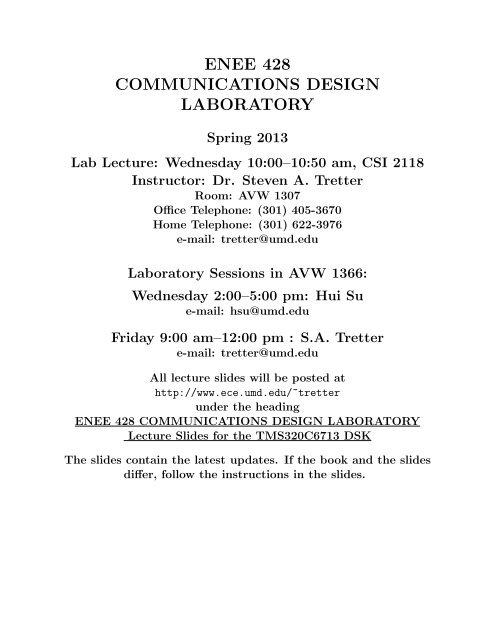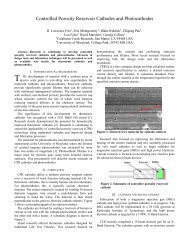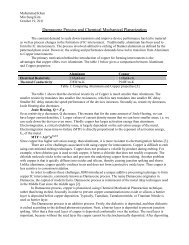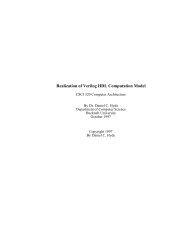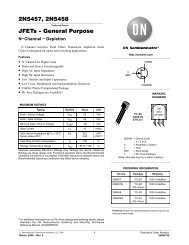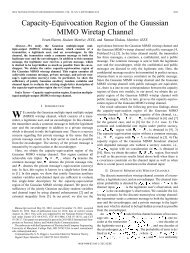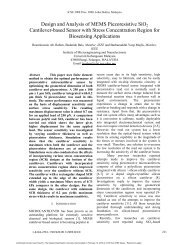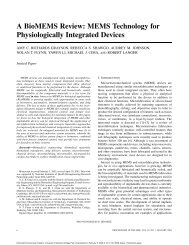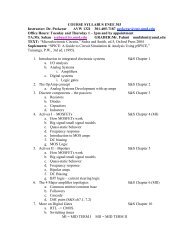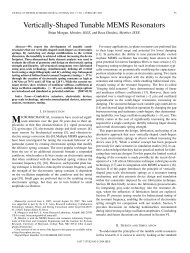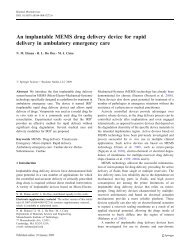ENEE 428 COMMUNICATIONS DESIGN LABORATORY - ECE
ENEE 428 COMMUNICATIONS DESIGN LABORATORY - ECE
ENEE 428 COMMUNICATIONS DESIGN LABORATORY - ECE
You also want an ePaper? Increase the reach of your titles
YUMPU automatically turns print PDFs into web optimized ePapers that Google loves.
<strong>ENEE</strong> <strong>428</strong><br />
<strong>COMMUNICATIONS</strong> <strong>DESIGN</strong><br />
<strong>LABORATORY</strong><br />
Spring 2013<br />
Lab Lecture: Wednesday 10:00–10:50 am, CSI 2118<br />
Instructor: Dr. Steven A. Tretter<br />
Room: AVW 1307<br />
Office Telephone: (301) 405-3670<br />
Home Telephone: (301) 622-3976<br />
e-mail: tretter@umd.edu<br />
Laboratory Sessions in AVW 1366:<br />
Wednesday 2:00–5:00 pm: Hui Su<br />
e-mail: hsu@umd.edu<br />
Friday 9:00 am–12:00 pm : S.A. Tretter<br />
e-mail: tretter@umd.edu<br />
All lecture slides will be posted at<br />
http://www.ece.umd.edu/~tretter<br />
under the heading<br />
<strong>ENEE</strong> <strong>428</strong> <strong>COMMUNICATIONS</strong> <strong>DESIGN</strong> <strong>LABORATORY</strong><br />
Lecture Slides for the TMS320C6713 DSK<br />
The slides contain the latest updates. If the book and the slides<br />
differ, follow the instructions in the slides.
<strong>ENEE</strong> <strong>428</strong> <strong>COMMUNICATIONS</strong> <strong>DESIGN</strong> <strong>LABORATORY</strong><br />
Prerequisites: <strong>ENEE</strong> 322 Signals and Systems and <strong>ENEE</strong> 324 Engineering Probability;<br />
Working knowledge of PC’s and C programming<br />
Corequisites: <strong>ENEE</strong> 420 Communication Systems or <strong>ENEE</strong> 425 Digital Signal Processing<br />
Text: Steven A. Tretter, Communication System Design Using DSP Algorithms with Laboratory<br />
Experiments for the TMS320C6713 DSK, Springer, 2008.<br />
Optional Reference Books:<br />
1. A C programming book like B.W. Kernighan and D.M. Ritchie, The C Programming<br />
Language, second edition, Prentice Hall, 1988. This is a detailed C reference, but not the<br />
best to learn from.<br />
2. A good book to learn C from is Herbert Schildt, Teach Yourself C, 2nd ed., Osborne<br />
McGraw-Hill, 1994.<br />
WARNING: Do not sign up for this class unless you like to work<br />
with PC’s and enjoy programming!<br />
COURSE DESCRIPTION<br />
The goal of the Communication Design Laboratory is to explore the signal processing and<br />
communication system theoretical concepts presented in <strong>ENEE</strong> 420 Communication Systems<br />
and <strong>ENEE</strong> 425 Digital Signal Processing by implementing them on actual hardware in real<br />
time. In the process, you will gain experience using equipment commonly used in industry,<br />
such as, oscilloscopes, spectrum analyzers, error rate test sets, channel simulators, digital<br />
signal processors, analog-to-digital and digital-to-analog converters, and signal generators.<br />
The experiments will be based on using a Texas Instruments TMS320C6713 DSP Starter<br />
Kit (DSK) which is a relatively low cost stand-alone board that communicates with the<br />
PC through a USB port. For our lab, the DSK has been mechanically installed inside the<br />
PC case. The DSK contains a TMS320C6713 floating point digital signal processor and<br />
stereo A/D and D/A converters. Software support includes a TMS320C6x assembler, and C<br />
compilers for the PC and DSP. You should have a good working knowledge of PC’s<br />
and some familiarity with C. The lab has eight stations and students will work in pairs.<br />
2
Experiments, Lab Reports, Grading, Etc.<br />
Experiments that Will be Done<br />
All students must complete the following items. Each experiment corresponds to one<br />
chapter in the text and may take more than one week.<br />
1. Chapter 1 Brief Overview of the Hardware and Software Tools<br />
2. Chapter 2 Learning to Use the Hardware and Software Tools by Generating a Sine<br />
Wave<br />
3. Chapter 3 Digital Filters<br />
4. Chapter 5 Amplitude Modulation<br />
5. Chapter 6 DSBSC Amplitude Modulation and Coherent Detection<br />
6. Chapter 8 Frequency Modulation<br />
7. Chapter 4 The FFT and Power Spectrum Estimation<br />
8. Additional experiments if time permits<br />
NOTE: You should read over the experiments before coming to<br />
lab and do any preliminary work necessary.<br />
Grading Criteria<br />
Your grade will be determined by the following items:<br />
• Grades on lab reports<br />
• Attendance at lecture and lab. Lack of attendance at either will reduce your grade.<br />
• Opinion of TA and instructor on your contribution to work in lab<br />
• Work done beyond minimum requirements<br />
Lab Reports<br />
Inform your TA when you have completed an experiment (chapter), or part of a chapter.<br />
Your TA will then ask you to demonstrate at a work station that your implementation is<br />
working correctly.<br />
Individual written lab reports are required. Part of what you will gain from this course<br />
is practice writing well organized reports. Documenting and communicating your work will<br />
be very important in your future jobs. The reports should be turned in within one week<br />
after you complete each experiment and will be graded by your TA on the basis of 20 points.<br />
No lab report is required for Chapter 1. Your TA will set deadlines for when the reports<br />
must be completed.<br />
When turning in your lab reports, please include all of the items listed below. (Your TA<br />
may modify these requirements.)<br />
3
1. Include the experiment title, your name, and your partner’s name on the first page.<br />
2. A printed listing of your commented C and, if used, assembly source code. It is not<br />
necessary to include standard header (.h) or other accessory files unless you created or<br />
modified them for the experiment.<br />
3. Answers to all questions asked in the lab manual.<br />
4. Include data listings and output from the various filter design programs when relevant.<br />
Include plots of filter frequency responses.<br />
5. Number pages, figures, and tables. Make captions for figures and tables.<br />
6. Be sure to label the axes of plots.<br />
7. Any additional items requested by your TA.<br />
8. A short introduction discussing the experiment at the beginning, and a section with<br />
your conclusions at the end.<br />
Lab Access<br />
The lab has a university ID card reader on the door. I will submit a class roster to the<br />
<strong>ECE</strong> office and you should then have access to the lab from 7 AM to 11 PM every day as<br />
long as you are not interfering with another class.<br />
Using the <strong>ECE</strong> Network<br />
You can log on to the lab PC’s using your university username and password. Each lab<br />
group will be given a private directory on the network server (ecelabsvr) that both group<br />
members can share. No other groups can read your directory. However, all administrators<br />
(including TA’s) can access it.<br />
Please do your program development in your network group directory so the local hard<br />
drive does not get cluttered up. The lab PC’s will be re-imaged each time they are rebooted<br />
and you will lose anything you saved on the C drive.<br />
It takes a long time for the PC’s to re-boot because of the re-imaging, so leave them on<br />
all the time.<br />
WARNING: Disk drives and networks sometimes crash! To be<br />
safe, you should back up your programs on a floppy disk or USB<br />
memory drive before you leave for the day.<br />
You can also use WinSCP to transfer files to and from your Glue account. That way, if<br />
the network is down you can still work from the local disks since all our utility software is<br />
stored on the C hard disk.<br />
4


